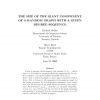Free Online Productivity Tools
i2Speak
i2Symbol
i2OCR
iTex2Img
iWeb2Print
iWeb2Shot
i2Type
iPdf2Split
iPdf2Merge
i2Bopomofo
i2Arabic
i2Style
i2Image
i2PDF
iLatex2Rtf
Sci2ools
CPC
1998
1998
The Size of the Giant Component of a Random Graph with a Given Degree Sequence
Given a sequence of non-negative real numbers 0 1 ::: which sum to 1, we consider a random graph having approximately in vertices of degree i. In 12] the authors essentially show that ifPi(i ; 2) i > 0 then the graph a.s. has a giant component, while ifPi(i ; 2) i < 0 then a.s. all components in the graph are small. In this paper we analyze the size of the giant component in the former case, and the structure of the graph formed by deleting that component. We determine 0 0 0 1 ::: such that a.s. the giant component, C, has n + o(n) vertices, and the structure of the graph remaining after deleting C is basically that of a random graph with n 0 = n;jCj vertices, and with 0 i n 0 of them of degree i. 1
| Added | 22 Dec 2010 |
| Updated | 22 Dec 2010 |
| Type | Journal |
| Year | 1998 |
| Where | CPC |
| Authors | Michael Molloy, Bruce A. Reed |
Comments (0)

